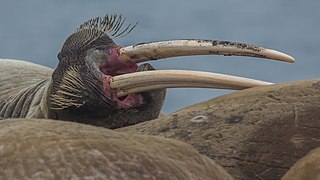
Sedimentary rocks are types of rock that are formed by the deposition and subsequent cementation of mineral or organic particles on the floor of oceans or other bodies of water at the Earth's surface. Sedimentation is the collective name for processes that cause these particles to settle in place. The particles that form a sedimentary rock are called sediment, and may be composed of geological detritus (minerals) or biological detritus. Before being deposited, the geological detritus was formed by weathering and erosion from the source area, and then transported to the place of deposition by water, wind, ice, mass movement or glaciers, which are called agents of denudation. Biological detritus was formed by bodies and parts of dead aquatic organisms, as well as their fecal mass, suspended in water and slowly piling up on the floor of water bodies. Sedimentation may also occur as dissolved minerals precipitate from water solution.
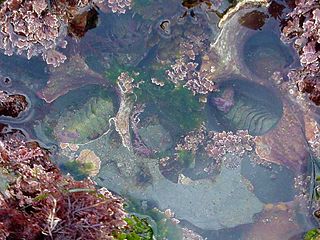
Benthos is the community of organisms that live on, in, or near the seabed, also known as the benthic zone. This community lives in or near marine sedimentary environments, from tidal pools along the foreshore, out to the continental shelf, and then down to the abyssal depths.

A trace fossil, also ichnofossil, is a geological record of biological activity. Ichnology is the study of such traces, and is the work of ichnologists. Trace fossils may consist of impressions made on or in the substrate by an organism: for example, burrows, borings (bioerosion), urolites, footprints and feeding marks, and root cavities. The term in its broadest sense also includes the remains of other organic material produced by an organism — for example coprolites or chemical markers — or sedimentological structures produced by biological means - for example, stromatolites. Trace fossils contrast with body fossils, which are the fossilized remains of parts of organisms' bodies, usually altered by later chemical activity or mineralization.
The pelagic zone consists of the water column of the open ocean, and can be further divided into regions by depth. The word "pelagic" is derived from Ancient Greek πέλαγος (pélagos), meaning 'open sea'. The pelagic zone can be thought of in terms of an imaginary cylinder or water column that goes from the surface of the sea almost to the bottom. Conditions differ deeper in the water column such that as pressure increases with depth, the temperature drops and less light penetrates. Depending on the depth, the water column, rather like the Earth's atmosphere, may be divided into different layers.

Fauna is all of the animal life present in a particular region or time. The corresponding term for plants is flora. Flora, fauna and other forms of life such as fungi are collectively referred to as biota. Zoologists and paleontologists use fauna to refer to a typical collection of animals found in a specific time or place, e.g. the "Sonoran Desert fauna" or the "Burgess Shale fauna". Paleontologists sometimes refer to a sequence of faunal stages, which is a series of rocks all containing similar fossils. The study of animals of a particular region is called faunistics.

The benthic zone is the ecological region at the lowest level of a body of water such as an ocean, lake, or stream, including the sediment surface and some sub-surface layers. Organisms living in this zone are called benthos and include microorganisms as well as larger invertebrates, such as crustaceans and polychaetes. Organisms here generally live in close relationship with the substrate and many are permanently attached to the bottom. The benthic boundary layer, which includes the bottom layer of water and the uppermost layer of sediment directly influenced by the overlying water, is an integral part of the benthic zone, as it greatly influences the biological activity that takes place there. Examples of contact soil layers include sand bottoms, rocky outcrops, coral, and bay mud.
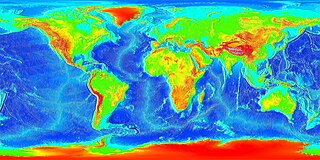
The seabed is the bottom of the ocean.
Axiidea is an infraorder of decapod crustaceans. Axiidea and Gebiidea are divergent infraoders of the former infraorder Thalassinidea. These infraorders have converged ecologically and morphologically as burrowing forms. It is now widely believed that these two infraorders represent two distinct lineages separate from one another; however, this separation occurred in 2009 based on molecular evidence. As a result, much of the literature and research surrounding these infraorders still refers to the Axiidea and Gebiidea in combination as "thalassinidean" for the sake of clarity and reference. This division based on molecular evidence is consistent with the groupings proposed by Robert Gurney in 1938 based on larval developmental stages.
Trace fossils are classified in various ways for different purposes. Traces can be classified taxonomically, ethologically, and toponomically, that is, according to their relationship to the surrounding sedimentary layers. Except in the rare cases where the original maker of a trace fossil can be identified with confidence, phylogenetic classification of trace fossils is an unreasonable proposition.
Sedimentary structures include all kinds of features formed at the time of deposition. Sediments and sedimentary rocks are characterized by bedding, which occurs when layers of sediment, with different particle sizes are deposited on top of each other. These beds range from millimeters to centimeters thick and can even go to meters or multiple meters thick.

The "Cambrian substrate revolution" or "Agronomic revolution", evidenced in trace fossils, is the diversification of animal burrowing during the early Cambrian period.

A microbial mat is a multi-layered sheet of microorganisms, mainly bacteria and archaea. Microbial mats grow at interfaces between different types of material, mostly on submerged or moist surfaces, but a few survive in deserts. They colonize environments ranging in temperature from –40 °C to 120 °C. A few are found as endosymbionts of animals.
Ediacaran type preservation relates to the dominant preservational mode in the Ediacaran period, where Ediacaran organisms were preserved as casts on the surface of microbial mats.
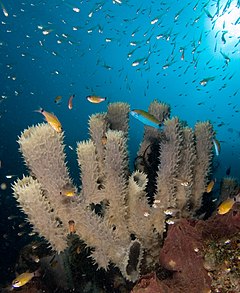
The marine environment supplies many kinds of habitats that support marine life. Marine life depends in some way on the saltwater that is in the sea. A habitat is an ecological or environmental area inhabited by one or more living species.
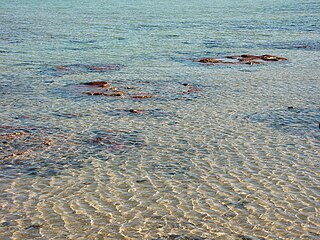
Shallow water marine environment refers to the area between the shore and deeper water, such as a reef wall or a shelf break. This environment is characterized by oceanic, geological and biological conditions, as described below. The water in this environment is shallow and clear, allowing the formation of different sedimentary structures, carbonate rocks, coral reefs, and allowing certain organisms to survive and become fossils.
Abarenicola pacifica or the Pacific lugworm is a large species of polychaete worm found on the west coast of North America and also in Japan. The worms live out of sight in burrows under the sand and produce casts which are visible on the surface.
Paleodictyon nodosum is a creature thought to produce a certain form of Paleodictyon burrow found around mid-ocean ridge systems in the Pacific and Atlantic Oceans. Although scientists have collected many of the burrows of Paleodictyon nodosum, they have never seen a live one. What a live specimen would look like is widely debated, with the debate being split into two main sides. Adolf Seilacher who discovered the original fossils of Paleodictyon nodosum hypothesizes that the creature is a worm-like species that burrows into the sediment around hydrothermal vents and deflects water flow through the burrows to catch food or farm its own food. Peter A. Rona, discoverer of the modern burrows, suggests that Paleodictyon nodosum may actually be a large protist. There are other known examples of protists reaching the sizes that Paleodictyon reaches, and they are known to be infaunal. Scientists ran various tests on the burrows of Paleodictyon and were unable to reach a single conclusion as to the form of Paleodictyon. The one thing that they can agree upon is that there are many markers that suggest that these forms are caused by a creature, and not by geological forces.
Listriolobus pelodes is a species of marine spoon worm. It is found in shallow seas in the North East Pacific off the coast of California. It lives in a burrow in soft sediments.

Spreite, meaning leaf-blade in German are stacked, curved, layered structures that are characteristic of certain trace fossils. They are formed by invertebrate organisms tunneling back and forth through sediment in search of food. The organism moves perpendicularly just enough at the start of each back-and-forth pass so that it avoids reworking a previously tunneled area, thereby ensuring that it only makes feeding passes through fresh, unworked sediment.



